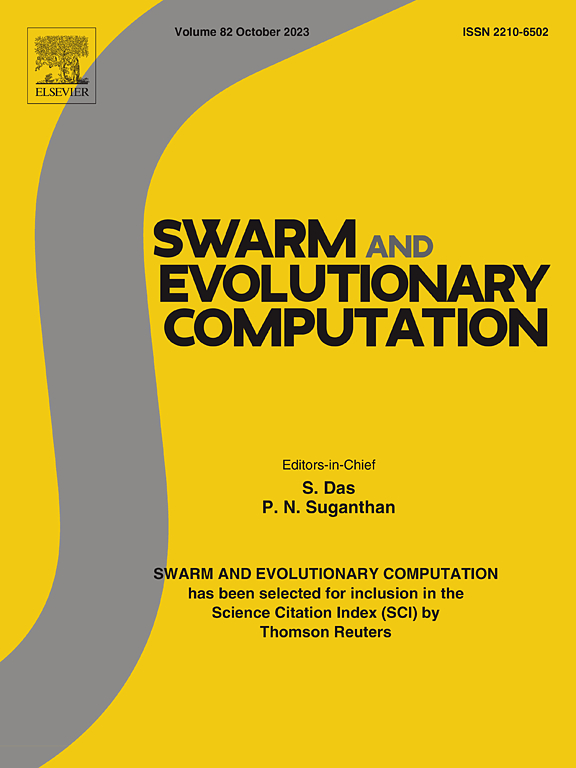基于博弈论约束优化的张量联合框架皮肤癌预测
IF 8.5
1区 计算机科学
Q1 COMPUTER SCIENCE, ARTIFICIAL INTELLIGENCE
引用次数: 0
摘要
皮肤癌发病率高,检测难度大,是一个令人关注的公共卫生问题。虽然张量分解被广泛用于预测mirna与疾病的关联,但现有模型并未针对皮肤癌进行优化,从而限制了其全面性和可解释性。为了解决这些限制,我们提出了一个多目标张量联合框架,旨在提高预测精度,同时保持全面性和可解释性。该框架根据张量与皮肤癌的相似度对张量进行分类,并采用多目标优化算法优化权重分配。皮肤癌的相似性约束被应用于相关信息的优先级,有效地减少了不相关疾病的噪音。在此基础上,提出了一种基于博弈论的多阶段约束多目标优化算法。该算法利用博弈论在进化过程中动态调整种群多样性、收敛性和约束违规,从而提高整体框架的性能。实验结果表明,该算法在MW和DTLZ等基准上优于现有的约束多目标优化算法。与其他张量分解方法相比,该框架在四个目标上实现了8.49% ~ 11.53%的综合改进。本文章由计算机程序翻译,如有差异,请以英文原文为准。
Tensor joint framework enhanced by game-theoretic constrained optimization for skin cancer forecasting
Skin cancer is a public health concern due to its high incidence and detection challenges. While tensor decomposition is widely utilized to predict miRNA-disease associations, existing models are not optimized for skin cancer, thereby limiting their comprehensiveness and interpretability. To address these limitations, we propose a many-objective tensor joint framework aimed at enhancing prediction accuracy while maintaining comprehensiveness and interpretability. The proposed framework classifies tensors according to their similarity to skin cancer and employs a many-objective optimization algorithm to optimize weight allocation. Similarity constraints for skin cancer are applied to prioritize relevant information, effectively minimizing noise from unrelated diseases. Furthermore, we introduce a multi-stage constrained many-objective optimization algorithm based on game theory. This algorithm leverages game theory to dynamically adjust population diversity, convergence, and constraint violations throughout the evolutionary process, thereby improving the overall framework’s performance. Experimental results demonstrate that the proposed algorithm outperforms existing state-of-the-art constrained many-objective optimization algorithms on benchmarks such as MW and DTLZ. Compared to other tensor decomposition methods, the proposed framework achieves a comprehensive improvement ranging from 8.49% to 11.53% across four objectives.
求助全文
通过发布文献求助,成功后即可免费获取论文全文。
去求助
来源期刊

Swarm and Evolutionary Computation
COMPUTER SCIENCE, ARTIFICIAL INTELLIGENCEC-COMPUTER SCIENCE, THEORY & METHODS
CiteScore
16.00
自引率
12.00%
发文量
169
期刊介绍:
Swarm and Evolutionary Computation is a pioneering peer-reviewed journal focused on the latest research and advancements in nature-inspired intelligent computation using swarm and evolutionary algorithms. It covers theoretical, experimental, and practical aspects of these paradigms and their hybrids, promoting interdisciplinary research. The journal prioritizes the publication of high-quality, original articles that push the boundaries of evolutionary computation and swarm intelligence. Additionally, it welcomes survey papers on current topics and novel applications. Topics of interest include but are not limited to: Genetic Algorithms, and Genetic Programming, Evolution Strategies, and Evolutionary Programming, Differential Evolution, Artificial Immune Systems, Particle Swarms, Ant Colony, Bacterial Foraging, Artificial Bees, Fireflies Algorithm, Harmony Search, Artificial Life, Digital Organisms, Estimation of Distribution Algorithms, Stochastic Diffusion Search, Quantum Computing, Nano Computing, Membrane Computing, Human-centric Computing, Hybridization of Algorithms, Memetic Computing, Autonomic Computing, Self-organizing systems, Combinatorial, Discrete, Binary, Constrained, Multi-objective, Multi-modal, Dynamic, and Large-scale Optimization.
 求助内容:
求助内容: 应助结果提醒方式:
应助结果提醒方式:


